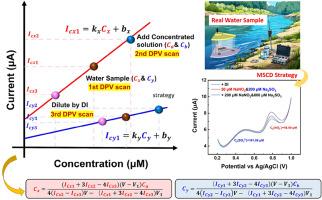Simultaneously calibrate and detect multiple analytes to offset the effects of co-existing regents and environmental fluctuations
IF 6
2区 化学
Q1 CHEMISTRY, ANALYTICAL
引用次数: 0
Abstract
Background
The real water bodies contain varieties of contaminants and varying with time and climate, for which a fast and accurate in-situ approaching for simultaneously detecting multiple pollutants would be urgently on demand. Although the differential pulse voltammetry (DPV) gives a promising approach for simultaneous detection of multiple pollutants due to the high-resolution characteristic oxidation-reduction peak of target pollutants, it is very sensitive to the unpredictable environmental fluctuations, which should be addressed through specific anti-interference techniques based on synchronously achieved data.
Results
A multi-pollutants simultaneous calibration and detection (MSCD) strategy and corresponding electrochemical sensors were proposed. Combined with the characteristic scanning potentials of analytes, a series of diluted or analyte-added water samples were detected, and a linear regression algorithm is developed to reduce the errors caused by interfering substances, unpredictable environmental fluctuations. Applied in the detection of 40–100 μM nitrite (NO2−) and 100–400 μM sulfite (SO32−), MSCD strategy has exhibited acceptable anti-interference to pH, temperature fluctuations and high concentration of interfering substances. In addition, the relative errors of multiple repeat measurements of nitrite and sulfite do not exceed 8.2 % and −8.3 %, respectively. When using different MSCD sensors, the relative errors were less than −11.6 % and 3.9 %, due to offsetting the deviation of fabrication batches. In the detection of actual water samples, the relative error is less than ±7.8 %, and proved to be significantly more accurate than commonly used electrochemical methods.
Significance
Compared with commonly used laboratory calibration methods, the proposed MSCD strategy exhibits excellent anti-interference performance in co-pollutant matrices with pH fluctuations and temperature changes. This MSCD strategy is expected to adapt to various electrochemical targets with appropriate sensing materials and provide an alternative option for simultaneously detecting multiple pollutants with high accuracy and repeatability.


同时校准和检测多种分析物,以抵消共存试剂和环境波动的影响
真实水体中含有多种污染物,且随时间和气候的变化而变化,迫切需要一种快速准确的同时检测多种污染物的原位逼近方法。差分脉冲伏安法(DPV)由于目标污染物的高分辨率特征氧化还原峰,为同时检测多种污染物提供了一种很有前途的方法,但它对不可预测的环境波动非常敏感,这需要通过基于同步获得的数据的特定抗干扰技术来解决。结果提出了一种多污染物同步校准检测(MSCD)策略和相应的电化学传感器。结合分析物的特征扫描电位,检测了一系列稀释或添加分析物的水样,并开发了线性回归算法,以减少干扰物质和不可预测的环境波动带来的误差。应用于40 ~ 100 μM亚硝酸盐(NO2-)和100 ~ 400 μM亚硫酸盐(SO32-)的检测,MSCD策略对pH、温度波动和高浓度干扰物质具有良好的抗干扰性。此外,亚硝酸盐和亚硫酸盐多次重复测量的相对误差分别不超过8.2%和-8.3%。当使用不同的MSCD传感器时,由于抵消了制造批次的偏差,相对误差分别小于-11.6%和3.9%。在实际水样的检测中,相对误差小于±7.8%,比常用的电化学方法精度显著提高。与常用的实验室校准方法相比,所提出的MSCD策略在pH波动和温度变化的共污染物基质中表现出优异的抗干扰性能。该MSCD策略有望通过合适的传感材料适应各种电化学目标,并为同时检测高精度和可重复性的多种污染物提供另一种选择。
本文章由计算机程序翻译,如有差异,请以英文原文为准。
求助全文
约1分钟内获得全文
求助全文
来源期刊

Analytica Chimica Acta
化学-分析化学
CiteScore
10.40
自引率
6.50%
发文量
1081
审稿时长
38 days
期刊介绍:
Analytica Chimica Acta has an open access mirror journal Analytica Chimica Acta: X, sharing the same aims and scope, editorial team, submission system and rigorous peer review.
Analytica Chimica Acta provides a forum for the rapid publication of original research, and critical, comprehensive reviews dealing with all aspects of fundamental and applied modern analytical chemistry. The journal welcomes the submission of research papers which report studies concerning the development of new and significant analytical methodologies. In determining the suitability of submitted articles for publication, particular scrutiny will be placed on the degree of novelty and impact of the research and the extent to which it adds to the existing body of knowledge in analytical chemistry.
 求助内容:
求助内容: 应助结果提醒方式:
应助结果提醒方式:


